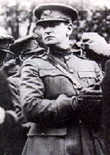|

YOU ARE HERE >> Irish Story > War > Heroes > Michael Collins
Michael Collins
Michael's father, Michael John Collins was sixty years old when he married Marianne O'Brien. Marianne was only twenty-three, but they were happy and went on to have eight children. His father was seventy-five when Michael was born. Michael's father was a farmer, living comfortably for the times on a holding of ninety acres, but died when Michael was six. At 15, Michael went to live in London with his sister and worked in a bank. He became active in the Gaelic Athletic League and in the Irish Republican Brotherhood (IRB). He was to become first the secretary and then the president of the IRB.
In 1916 Collins returned to Dublin to take part in the planned Easter Rising. He received a Volunteer's uniform and was second in command to Joseph Mary Plunkett in the General Post Office. Though he played only a minor part in the Rising, his sense of duty and clear-headedness were remembered.
Following the Rising, Michael was sent as a prisoner to Richmond Barracks and later to Frongoch internment camp in Wales. Released in December 1916, he returned to Ireland and rebuilt the IRB.
In 1919, Collins, with the help of his friend Harry Boland, another IRB man, went to Lincoln gaol in England to help Eamon de Valera escape. While de Valera was in America trying to raise money for Sinn Fein, Michael risked his life to visit de Valera's wife Sinead and their children.
On 21 November 1920 Michael Collins' squad in what was now called the IRA [Irish Republican Army] assassinated 14 British officers, effectively destroying the British Secret Service in Ireland. In reprisal, the Black and Tans fired on a crowd watching a football match at Croke Park. Twelve people were killed, including one of the team players. The day became known as Bloody Sunday.
In May of 1921, the IRA set ablaze the Dublin Custom House, but Crown forces arrived in time to capture nearly the entire Dublin IRA Brigade. After this action, the IRA were short of men and weapons, but at the same time, the British were completely demoralised with public opinion increasingly against continued repression. The commander of His Majesty's Crown forces in Ireland advised David Lloyd George to 'go all out or get out'. Treaty talks began.
Named by Eamon de Valera as a delegate, with Arthur Griffiths, to negotiate with the British about forming a republic, Collins protested that he was a soldier, not a politician, but he was forced to go. Collins knew that a Republic that included Ulster was not possible under the present conditions, but he hoped for a boundary commission that would redraw the border to include much of Catholic Fermanagh and Tyrone in the newly created Free State.
This left the problem of the Oath of Allegiance. Collins thought that a reworded oath might pass a Dail vote, and though opposed by de Valera, would pave the way for future concessions once British troops withdrew. Reluctantly, the delegation signed. Collins knew the treaty would be received badly in Dublin, but decided that a step toward Irish independence was preferable to an all-out war. After signing the treaty he said, "...I tell you, I have signed my death warrant".
Across the country, the IRA split into pro-Treaty and anti-Treaty forces. Many followed Collins, accepting that the Treaty gave the country the 'freedom to win freedom'. On 12 August 1922, Arthur Griffith died of a massive hemorrhage. He had never recovered from the strain of the Treaty negotiations.
Eight days later, though ill with stomach trouble that had plagued him for several months and suffering from a bad cold, Michael Collins left on a mission to visit troops in his home county of Cork. Warned not to go, he said "They wouldn't shoot me in my own county". He visited several anti-Treaty men as well as inspecting various barracks.
On 22 August 1922, he set out from Cork in a convoy, which was ambushed at a place known as Beal na mBlath [the mouth of flowers]. Only one man was killed: Michael Collins. It is thought that Irregulars did the shooting, but some say that it might have been his own men. To this day, there is controversy about what actually happened.

Links
Copyright | Site Map | Contact Us
